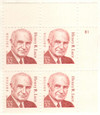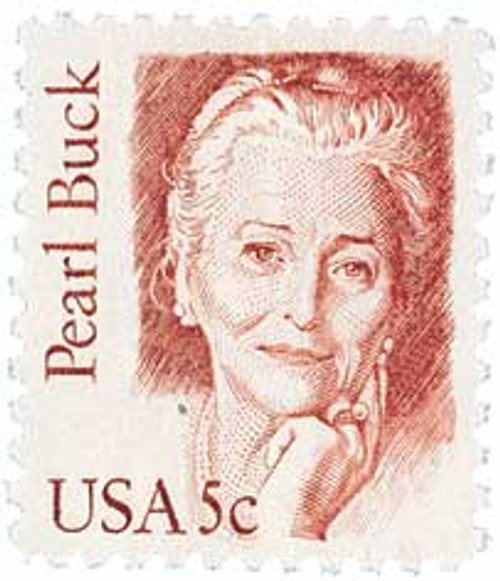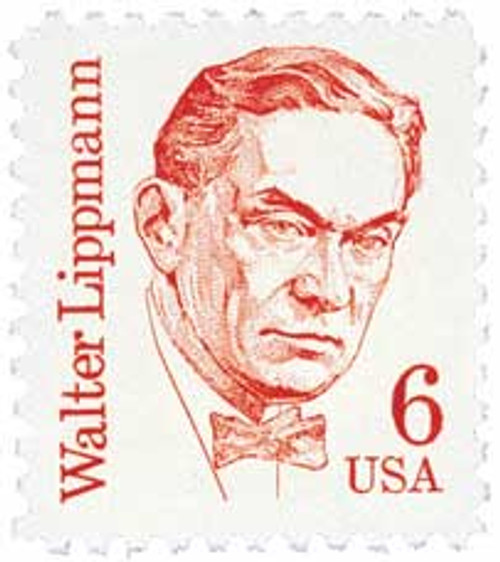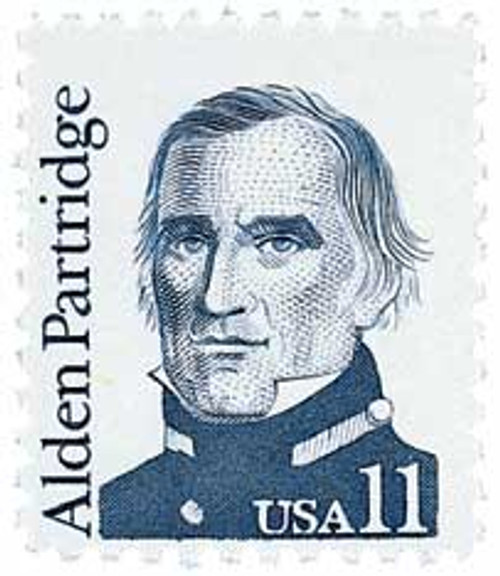
# 2935 - 1998 32c Great Americans: Henry R. Luce
US #2935
1998 Henry Luce
- 60th stamp in Great Americans Series
- Honors magazine publisher and editor
- Issued on the 100th anniversary of Luce’s birth
Category of Stamp: Definitive
Set: Great Americans
Value: 32¢, Fist Class Mail rate
First Day of Issue: April 3, 1998
First Day City: New York, New York
Quantity Issued: 30,250,000
Printed by: Banknote Corporation of America
Printing Method/Format: Engraved. Issued in panes of 20, from printing plates of 320 (20 across, 16 down)
Perforations: 11.2
Color: Lake
Reason the stamp was issued: This stamp honors Henry R. Luce, founder of Time, Fortune, Life, and Sports Illustrated magazines. It was issued on his 100th birthday.
About the stamp design: The Luce stamp follows the pattern of the Great American stamps. It’s a single color. The image for the stamp is from a photo portrait by Alfred Eisenstaedt. (He is the talent behind the famous photo of a sailor kissing a nurse on V-J Day.) The stamp originally identified Luce as “Publisher,” but his son said he preferred “Editor.”
About the printing process: This was the first lower-denomination Great American stamp issued in booklet format. The majority of stamps were produced in panes of 100. Other exceptions are the Jack London, Johns Hopkins, and Bret Harte stamps, which were also issued as booklets.
First Day City: The stamp was dedicated at the Time-Life Building in New York City. Luce’s son spoke at the ceremony, along with the chairman and CEO of Time Warner Inc.
About the Great American Series: The Great Americans Series was created to replace the Americana Series. The new series would be characterized by a standard definitive size, simple design, and monochromatic colors.
This simple design included a portrait, “USA,” the denomination, the person’s name, and in some cases, their occupation or reason for recognition. The first stamp in the new series was issued on December 27, 1980. It honored Sequoyah and fulfilled the new international postcard rate that would go into effect in January 1981.
The Great Americans Series would honor a wider range of people than the previous Prominent Americans and Liberty Series. While those series mainly honored presidents and politicians, the Great Americans Series featured people from many fields and ethnicities. They were individuals who were leaders in education, the military, literature, the arts, and human and civil rights. Plus, while the previous series only honored a few women, the Great Americans featured 15 women. This was also the first definitive series to honor Native Americans, with five stamps.
The Bureau of Engraving and Printing (BEP) produced most of the stamps, but private firms printed some. Several stamps saw multiple printings. The result was many different varieties, with tagging being the key to understanding them. Though there were also differences in perforations, gum, paper, and ink color.
The final stamp in the series was issued on July 17, 1999, honoring Justin S. Morrill. Spanning 20 years, the Great Americans was the longest-running US definitive series. It was also the largest series of face-different stamps, with a total of 63.
History the stamp represents:
Magazine magnate Henry Robinson Luce was born on April 3, 1898, in Tengchow, Shandong, China. He spent much of his childhood in China where his parents were Presbyterian missionaries. Luce attended Chinese and English boarding schools until he was 15, at which point he was sent to the Hotchkiss School in Connecticut.
At Hotchkiss, Luce edited the school’s Literary Monthly and met Briton Hadden, who would become a lifelong business partner. The pair went on to attend Yale College, where they both worked on The Yale Daily News. At Yale, Luce was voted “most brilliant” in his class. After graduating in 1920, Luce spent a year at Oxford University before working as a reporter for the Chicago Daily News.
In 1921, Luce joined Hadden at The Baltimore News. They spent many late nights talking about starting their own news magazine and decided to quit the newspaper together in 1922. Later that year they partnered with two other men to form Time Inc., and published the first issue of Time on March 3, 1923. Initially, Luce served as business manager while Hadden was editor-in-chief. They would then trade the titles of president and secretary-treasurer every year. Hadden’s sudden death in 1929 brought an end to their partnership.
Luce went on to start his business magazine, Fortune, in February 1930. He also bought Life and reformatted it as a weekly magazine featuring photojournalism in 1936. During World War II, many other magazine publishers opposed Luce. President Roosevelt issued a decree that forbid publishers and media executives from visiting combat areas. This was mainly targeted at Luce, who had spoken out against the president for some time.
In the 1940s, Luce wrote a now-famous article in Life called “The American Century,” which encouraged American dominance in world affairs for the rest of the century. After the war, Luce started House & Home in 1952 and Sports Illustrated in 1954. By the mid-1960s, Time Inc. was the largest and most popular magazine producer in the world. Luce served as editor-in-chief of all his magazines until 1964.
Luce supported a number of causes during his lifetime including the Save the Children Federation, the Metropolitan Museum of Art, and United Service to China. He died on February 28, 1967.
US #2935
1998 Henry Luce
- 60th stamp in Great Americans Series
- Honors magazine publisher and editor
- Issued on the 100th anniversary of Luce’s birth
Category of Stamp: Definitive
Set: Great Americans
Value: 32¢, Fist Class Mail rate
First Day of Issue: April 3, 1998
First Day City: New York, New York
Quantity Issued: 30,250,000
Printed by: Banknote Corporation of America
Printing Method/Format: Engraved. Issued in panes of 20, from printing plates of 320 (20 across, 16 down)
Perforations: 11.2
Color: Lake
Reason the stamp was issued: This stamp honors Henry R. Luce, founder of Time, Fortune, Life, and Sports Illustrated magazines. It was issued on his 100th birthday.
About the stamp design: The Luce stamp follows the pattern of the Great American stamps. It’s a single color. The image for the stamp is from a photo portrait by Alfred Eisenstaedt. (He is the talent behind the famous photo of a sailor kissing a nurse on V-J Day.) The stamp originally identified Luce as “Publisher,” but his son said he preferred “Editor.”
About the printing process: This was the first lower-denomination Great American stamp issued in booklet format. The majority of stamps were produced in panes of 100. Other exceptions are the Jack London, Johns Hopkins, and Bret Harte stamps, which were also issued as booklets.
First Day City: The stamp was dedicated at the Time-Life Building in New York City. Luce’s son spoke at the ceremony, along with the chairman and CEO of Time Warner Inc.
About the Great American Series: The Great Americans Series was created to replace the Americana Series. The new series would be characterized by a standard definitive size, simple design, and monochromatic colors.
This simple design included a portrait, “USA,” the denomination, the person’s name, and in some cases, their occupation or reason for recognition. The first stamp in the new series was issued on December 27, 1980. It honored Sequoyah and fulfilled the new international postcard rate that would go into effect in January 1981.
The Great Americans Series would honor a wider range of people than the previous Prominent Americans and Liberty Series. While those series mainly honored presidents and politicians, the Great Americans Series featured people from many fields and ethnicities. They were individuals who were leaders in education, the military, literature, the arts, and human and civil rights. Plus, while the previous series only honored a few women, the Great Americans featured 15 women. This was also the first definitive series to honor Native Americans, with five stamps.
The Bureau of Engraving and Printing (BEP) produced most of the stamps, but private firms printed some. Several stamps saw multiple printings. The result was many different varieties, with tagging being the key to understanding them. Though there were also differences in perforations, gum, paper, and ink color.
The final stamp in the series was issued on July 17, 1999, honoring Justin S. Morrill. Spanning 20 years, the Great Americans was the longest-running US definitive series. It was also the largest series of face-different stamps, with a total of 63.
History the stamp represents:
Magazine magnate Henry Robinson Luce was born on April 3, 1898, in Tengchow, Shandong, China. He spent much of his childhood in China where his parents were Presbyterian missionaries. Luce attended Chinese and English boarding schools until he was 15, at which point he was sent to the Hotchkiss School in Connecticut.
At Hotchkiss, Luce edited the school’s Literary Monthly and met Briton Hadden, who would become a lifelong business partner. The pair went on to attend Yale College, where they both worked on The Yale Daily News. At Yale, Luce was voted “most brilliant” in his class. After graduating in 1920, Luce spent a year at Oxford University before working as a reporter for the Chicago Daily News.
In 1921, Luce joined Hadden at The Baltimore News. They spent many late nights talking about starting their own news magazine and decided to quit the newspaper together in 1922. Later that year they partnered with two other men to form Time Inc., and published the first issue of Time on March 3, 1923. Initially, Luce served as business manager while Hadden was editor-in-chief. They would then trade the titles of president and secretary-treasurer every year. Hadden’s sudden death in 1929 brought an end to their partnership.
Luce went on to start his business magazine, Fortune, in February 1930. He also bought Life and reformatted it as a weekly magazine featuring photojournalism in 1936. During World War II, many other magazine publishers opposed Luce. President Roosevelt issued a decree that forbid publishers and media executives from visiting combat areas. This was mainly targeted at Luce, who had spoken out against the president for some time.
In the 1940s, Luce wrote a now-famous article in Life called “The American Century,” which encouraged American dominance in world affairs for the rest of the century. After the war, Luce started House & Home in 1952 and Sports Illustrated in 1954. By the mid-1960s, Time Inc. was the largest and most popular magazine producer in the world. Luce served as editor-in-chief of all his magazines until 1964.
Luce supported a number of causes during his lifetime including the Save the Children Federation, the Metropolitan Museum of Art, and United Service to China. He died on February 28, 1967.



















